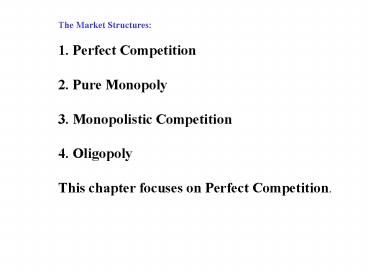The Market Structures: - PowerPoint PPT Presentation
Title:
The Market Structures:
Description:
4. Oligopoly. This chapter focuses on Perfect Competition. Perfect Competition ... The profit maximizing rule, MR=MC, together with the ... – PowerPoint PPT presentation
Number of Views:58
Avg rating:3.0/5.0
Title: The Market Structures:
1
The Market Structures 1. Perfect
Competition 2. Pure Monopoly 3. Monopolistic
Competition 4. Oligopoly This chapter focuses
on Perfect Competition.
2
Perfect Competition
3
Perfect Competition is defined as a market
where 1. Perfect information 2. Freedom of
entry and exit 3. Numerous buyers and
sellers 4. Standardized (homogeneous) product
4
(No Transcript)
5
The profit maximizing rule, MRMC, together with
the fact of flat demand (implying PMR) imply
that the profit maximizing output under perfect
competition will be where PMC.
6
Short Run Profits Under Perfect Competition
Since profit is R- C, it can also be written as
PQ-ACQ or (P-AC)Q. Notice that (P-AC)DE in
the drawing, and that QEC in the drawing.
Therefore the profit is the area of the rectangle
and is the product, DEEC.
7
(No Transcript)
8
(No Transcript)
9
(No Transcript)
10
(No Transcript)
11
(No Transcript)
12
What markets are like the wheat farming
example? 1. Automobiles? 2. Utilities? 3. Dot
Coms? 4. Physician care? 5. Gas statitions? 6.
Stocks and bonds?
13
What the theoretical perfect competition does
especially well Efficiency Competition
ideally results in Pareto Optimality, a form
of efficiency that takes advantage of every
possibility for mutual gain. That is, you
couldnt make even one person better off without
taking from someone else.
14
That is, perfect competition is good at 1.
Producers are technically efficient. 2.
Producers are allocatively efficient. 3.
Consumers are also efficient. 4. Even the
producers and consumers are coordinated in an
efficient way.
15
That is, it is also good at 1. Supply equals
demand. 2. Society is on the production
possibilities frontier, too.
16
But, what the competitive market society does
not guarantee 1. There may still be poor, sick
or hungry families. 2. True talent may not be
rewarded. 3. Some market outcomes will
undoubtedly seem unjust to many people.
17
- Is it our economy?
- Differences between the competitive
- market assumptions and United States
- reality
- Most of our GDP is produced in markets
- where firms have at least some market power.
- 2. Information is often imperfect.
- 3. In some markets, entry and exit isnt free.
- 4. Products are often differentiated.
- 5. There are many public goods and externalities.
18
The Soviet model was a command economy.
For example, prices were administered. For
popular goods, such as bread or vodka, prices
were kept artificially low to please the
population.
19
(No Transcript)
20
Thus, an important difference between a command
system (e.g. USSR) and a market system (e.g. US)
is is that market systems allow the markets to
reach their equilibrium.
21
Soviet leaders feared the U.S. power and
distrusted our intentions. The result was much
economic capital sunk into the arms races.
22
And, the space race.
23
Another importance difference is that market
systems provide individuals with incentives to
provide market goods efficiently.
And, markets generate a great deal of
information that central planners cannot
possibly have at hand. And, market systems learn
by trial and error. And, market systems respect
individual wants.
24
(No Transcript)































